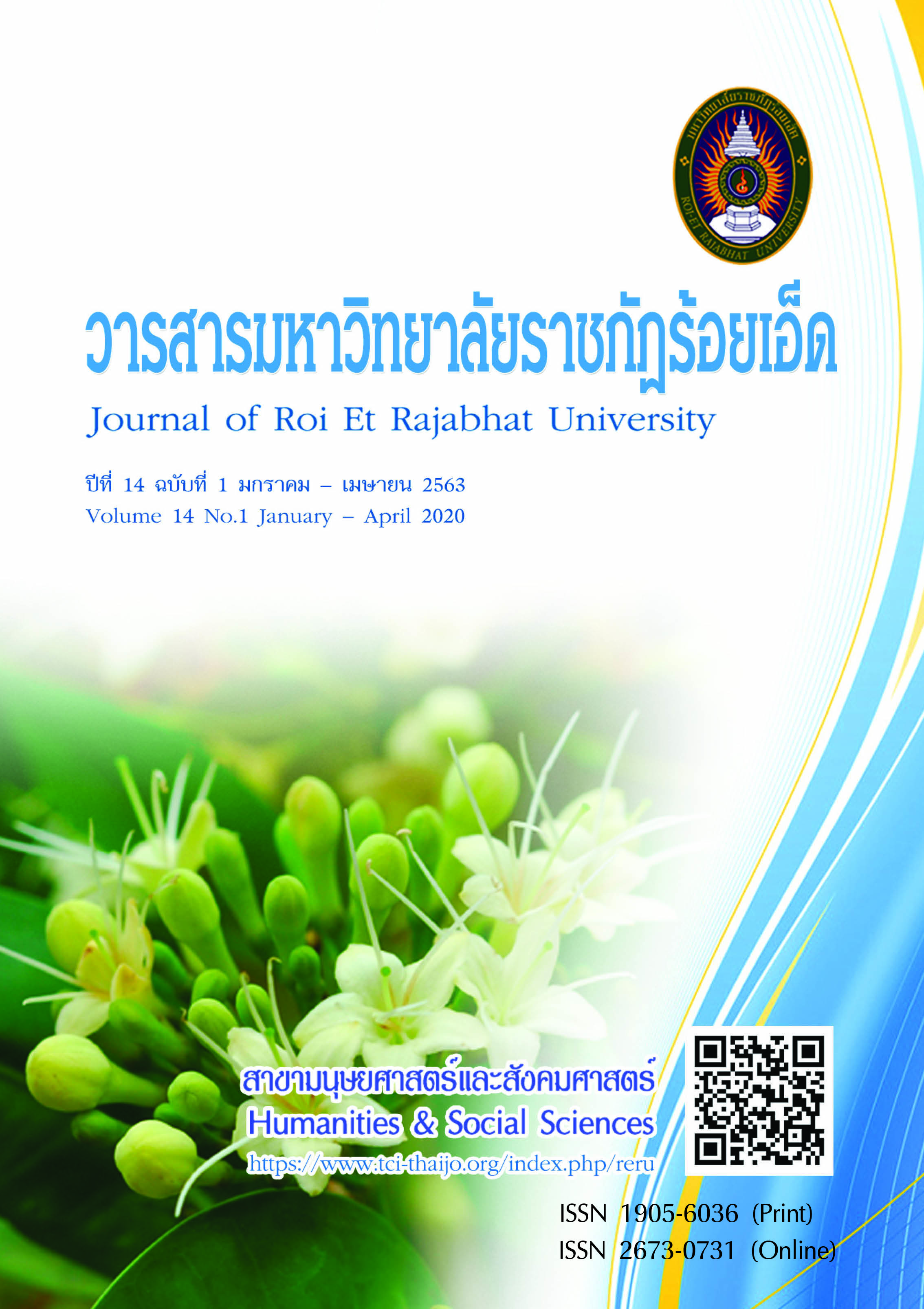- Development of Indicator on Information, Media and Technology Skills of Lower Secondary School Students in Schools under the Sakon Nakhon Primary Educational Service Area Office 2
Keywords:
Indicator development, Information, Media and Technology Skills, lower secondary school studentsAbstract
The proposes of this research were to develop the indicators on information, media and technology skills of lower secondary school students in schools under the Sakon Nakhon Primary Educational Service Area Office 2 and examine the congruence of the structural model on indicators of information, media and technology skills with the empirical data. The study was conducted into 2 phases. The first phase was the development indicators on information, media and technology skills of lower secondary school students by analyzing relevant documents and researches and interviewing 5 experts. The second phase was congruence examination between the developed hypothetical indicators with empirical data. The samples consisted of 350 teachers those teach lower secondary level, Schools under the Sakon Nakhon Primary Education Service Area Office 1. The research tool employed was a 5-level rating scale questionnaires with IOC between .80 – 1.00, discrimination value between .33 - .78 and overall reliability value at .97. The collected data was analyzed by using SPSS and LISREL program. The results of this study were as follows: 1) Information, media and technology skills of lower secondary school students comprised 3 main components, 13 sub-components and 66 indicators those can be classified into 16 indicators on Information skills, 20 indicators on media skills, and 30 indicators on technology skills. 2) The structural model on information, media and technology skills of lower secondary school students was related to the empirical data on chi-square = 43.33, degree of freedom (df) = 46, P-value = .58, Goodness of Fit Index (GFI) = .98, Adjusted Goodness of Fit Index (AGFI) = .96 and Root Mean Square Error of Approximation (RMSEA) = .00
References
กระทรวงเทคโนโลยีสารสนเทศและการสื่อสาร (MICT). (2559). กระทรวงไอซีที ผนึก ATCI และ สพฐ.เดินหน้าส่งเสริมการเข้าถึง
ICT ของเด็กไทย เตรียมพร้อมเพื่อการเรียนรู้ในศตวรรษที่ 21. กรุงเทพฯ: ไอเดียเวิร์คส์ คอมมิวนิเคชั่นส์.
กระทรวงศึกษาธิการ. (2551). หลักสูตรแกนกลางการศึกษาขั้นพื้นฐาน พุทธศักราช 2551. กรุงเทพฯ: โรงพิมพ์ชุมนุมสหกรณ์การเกษตรแห่งประเทศไทย จำกัด.
ณัฐกานต์ ภาคพรต และณมน จีรังสุวรรณ. (2557). การเปรียบเทียบทักษะด้านสารสนเทศสื่อและไอซีที สำหรับนักเรียนชั้นประถมศึกษาปีที่ 1 ด้วยการประเมินตามสภาพจริง กับความคาดหวัง. วารสารมหาวิทยาลัยราชภัฏยะลา, 9(2), 35-45.
นงลักษณ์ วิรัชชัย. (2551). การพัฒนาตัวบ่งชี้การประเมิน. การประชุมวิชาการ เปิดขอบฟ้าคุณธรรมจริยธรรม ครั้งที่ 1. 29 สิงหาคม 2551. โรงแรมแอมบาสเดอร์. ศูนย์ส่งเสริมและพัฒนาพลังแผ่นดินเชิงคุณธรรม.
เบญจวรรณ ถนอมชยธวัช. (2559). ทักษะแห่งศตวรรษที่ 21: ความท้าทายในการพัฒนานักศึกษา 21st Century Skills: A Challenge for Student Development. วารสารเครือข่ายวิทยาลัยพยาบาลและการสาธารณสุขภาคใต้, 3(2), 208-222.
ประสาท เนืองเฉลิม. (2558). แนวการเรียนรู ้วิทยาศาสตร์ในศตวรรษที่ 21 21st Century Learning in Science. วารสารพัฒนาการเรียนการสอนมหาวิทยาลัยรังสิต, 9(1), 136-154.
ปาจรีย์ ทรงเสรีย์. (2559). ปัจจัยทางจิตสังคมที่เกี่ยวข้องกับพฤติกรรมใฝ่เรียนรู้ และทักษะแห่งศตวรรษที่ 21 ของนักเรียนชั้นมัธยมศึกษาตอนต้น สังกัดสำนักงานเขตพื้นที่การศึกษามัธยมศึกษา เขต 1 กรุงเทพมหานคร. วิทยานิพนธ์ วิทยาศาสตรมหาบัณฑิต สาขาวิชาการวิจัยพฤติกรรมศาสตร์ประยุกต์. กรุงเทพฯ: มหาวิทยาลัยศรีนครินทรวิโรฒ.
พรทิพย์ เย็นจะบก. (2558). เด็กไทยรู้เท่าทันสื่อ ฉลาดรู้...ฉลาดเลือก. กรุงเทพฯ: องค์การสงเคราะห์ทหารผ่านศึก.
ลักษณา พงษ์ภุมมา. (2560). ปัญหาของวัยรุ่นในสังคมไทย. สืบค้นเมื่อ 20 กรกฎาคม 2561, จาก http://164.115.41.60/knowledge/?p=436.
วันเพ็ญ นันทะศรี. (2556). การพัฒนาตัวบ่งชี้ภาวะผู้นำทางวิชาการสำหรับครูปฐมวัย สังกัดสำนักงานเขตพื้นที่การศึกษาประถมศึกษาในภาคตะวันออกเฉียงเหนือ. วารสารวิชาการและวิจัยสังคมศาสตร์ มหาวิทยาลัยราชภัฏนครสวรรค์, 8(23), 42.
วิจารณ์ พานิช. (2555). วิถีสร้างการเรียนรู้เพื่อศิษย์ ในศตวรรษที่ 21. กรุงเทพฯ: มูลนิธิสดศรีสฤษดิ์วงศ์.
วิจารณ์ พานิช. (2556). การสร้างการเรียนรู้สู่ศตวรรษที่ 21. กรุงเทพฯ: มูลนิธิสยามกัมมาจล. ส. เจริญการพิมพ์.
ศศิธร บัวทอง. (2560). การวัดและประเมินทักษะการเรียนรู้ ในศตวรรษที่ 21. วารสารมหาวิทยาลัยศิลปากร สาขามนุษยศาสตร์ สังคมศาสตร์ และศิลปะ, 10(2), 1856-1867.
ไสว ฟักขาว. (2560). ทักษะแห่งศตวรรษที่ 21 (21st Century skills). สืบค้นเมื่อ 18 พฤศจิกายน 2560, จาก www.e-manage.mju.ac.th/openFile.aspx?id=MjI5Mzc3.
สุรศักดิ์ ปาเฮ. (2556). ทักษะการเรียนรู้ในศตวรรษที่ 21 (21st Century Learning Skills). สืบค้นเมื่อ 1 เมษายน 2561, จาก https://www.slideshare.net/taxiboat/21-23558246.
สำนักงานเลขาธิการสภาการศึกษากระทรวงศึกษาธิการ. (2560). แผนการศึกษาแห่งชาติ พ.ศ. 2560-2579. กรุงเทพฯ: พริกหวานกราฟฟิค.
อัครเดช นีละโยธิน. (2559). ตัวบ่งชี้ทักษะของนักเรียนในศตวรรษที่ 21 สำหรับการศึกษาขั้นพื้นฐาน: การพัฒนาโมเดลความสัมพันธ์เชิงโครงสร้าง. ดุษฎีนิพนธ์ ศึกษาศาสตรดุษฎีบัณฑิต สาขาวิชาการบริหารการศึกษา. กรุงเทพฯ: มหาวิทยาลัยมหามงกุฎราชวิทยาลัย.
อดุลย์ วังศรีคูณ. (2557). การศึกษาไทยในศตวรรษที่ 21: ผลผลิตและแนวทางการพัฒนา. วารสารมนุษยศาสตร์และสังคมศาสตร์ บัณฑิตวิทยาลัยมหาวิทยาลัยราชภัฏพิบูลสงคราม, 8(1), 1-17.
อนุชา โสมาบุตร. (2556). ทักษะด้านสารสนเทศ สื่อ และเทคโนโลยี สำหรับการเรียนรู้แห่งศตวรรษที่ 21. สืบค้นเมื่อ 25 ตุลาคม 2560, จาก https://teacherweekly.wordpress.com/2013/09/25/information-media-and-technology-skills/.
Downloads
Published
How to Cite
Issue
Section
License
บทความที่ได้รับการตีพิมพ์เป็นลิขสิทธิ์ของวารสารมหาวิทยาลัยราชภัฎร้อยเอ็ด
ข้อความที่ปรากฏในบทความแต่ละเรื่องในวารสารวิชาการเล่มนี้เป็นความคิดเห็นส่วนตัวของผู้เขียนแต่ละท่านไม่เกี่ยวข้องกับมหาวิทยาลัยราชภัฎร้อยเอ็ด และคณาจารย์ท่านอื่นๆในมหาวิทยาลัยฯ แต่อย่างใด ความรับผิดชอบองค์ประกอบทั้งหมดของบทความแต่ละเรื่องเป็นของผู้เขียนแต่ละท่าน หากมีความผิดพลาดใดๆ ผู้เขียนแต่ละท่านจะรับผิดชอบบทความของตนเองแต่ผู้เดียว





